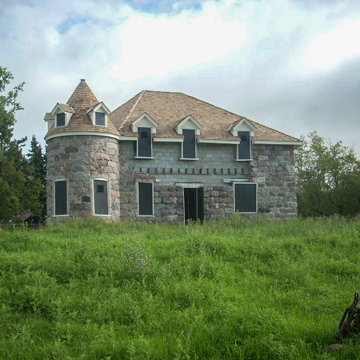In 1902, seven years after the death of his wife, Nellie, Maurice Coghlan hired Thomas Bowyer, a Manitoba, Canada, stonemason, to build a large fanciful house for his five sons on the family’s one-hundred-and-sixty-acre homestead. The fieldstone two-story house and its attached round tower is an impressive demonstration of stone masonry and hand craftsmanship. Bowyer gathered the large fieldstones, known as “glacial erratics,” to build the house. Bowyer’s grandfather Samuel and his sons were a family of three generations of stonemasons who emigrated from Scotland and worked extensively along the Manitoba and North Dakota border constructing mostly barns and other farm buildings. Several comparable granite boulder stone houses have been identified just across the border in Manitoba. Interior work on Coghlan Castle was impressively crafted by Maurice’s brother John, who was a master carpenter for the Pullman Railroad Car Company. The house was further adorned with stained glass windows and decorative plasterwork. In the first decade of the twenty-first century, the house has been the subject of restoration field schools conducted by Preservation North Dakota.
You are here
Coghlan Castle
1902–1904, Maurice and John Coghlan; Thomas Bowyer, mason. East side of 48th Ave. NE, 1.5 miles south of ND 42, southeast of St. John
If SAH Archipedia has been useful to you, please consider supporting it.
SAH Archipedia tells the story of the United States through its buildings, landscapes, and cities. This freely available resource empowers the public with authoritative knowledge that deepens their understanding and appreciation of the built environment. But the Society of Architectural Historians, which created SAH Archipedia with University of Virginia Press, needs your support to maintain the high-caliber research, writing, photography, cartography, editing, design, and programming that make SAH Archipedia a trusted online resource available to all who value the history of place, heritage tourism, and learning.











